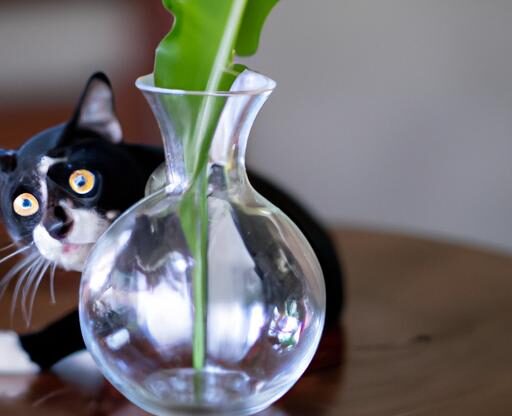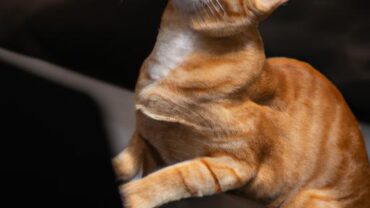Cat Bumping into Things: Navigating the Whimsical World of Feline Clumsiness
Introduction
Ah, the curious and often comical nature of our feline friends! Have you ever wondered why your graceful cat occasionally stumbles upon objects, creating moments of pure hilarity? Well, fear not, for we are about to embark on a journey to unravel the mysteries behind our cats’ endearing clumsiness. In this article, we delve into the peculiar phenomenon of cats bumping into things and explore its significance in their whimsical world.
Cats, those enigmatic creatures that prowl our homes with an air of regality, are not immune to the occasional mishap. Picture this: a cat gracefully strutting through a room, only to be abruptly interrupted by a sudden collision with a piece of furniture or a wall. It’s enough to make anyone burst into laughter! But why does this happen?
In their quest for exploration and adventure, cats possess an innate curiosity that often leads them into precarious situations. Whether it’s chasing a toy, pursuing a glimpse of movement, or simply misjudging distances, cats can find themselves bumping into objects more frequently than we may expect. These scenarios serve as a reminder of their vulnerability and add a touch of whimsy to our daily lives.
Stay tuned as we journey deeper into the fascinating world of cat vision and the factors that contribute to our feline companions’ occasional rendezvous with the unseen. We’ll explore how understanding their unique perspective can help us create a safer environment, reduce the likelihood of mishaps, and ensure our furry friends continue to captivate us with their charming clumsiness.
So, let’s dive in and unravel the secrets behind our cats’ propensity for bumping into things. Together, we’ll navigate this enchanting realm, discovering the joys hidden within each playful collision.
Understanding Cat Vision
Unique Characteristics of Cat Vision
Have you ever marveled at your cat’s ability to effortlessly pounce on a moving target, yet still find themselves unexpectedly colliding with stationary objects? Understanding the unique characteristics of cat vision provides valuable insights into this seemingly contradictory behavior.
Unlike humans, who rely heavily on color perception, cats possess a visual system designed for nocturnal hunting. Their eyes are equipped with a larger number of rod cells, specialized for low-light conditions, while their cone cells, responsible for color vision, are relatively scarce. This disparity in cell distribution grants cats exceptional night vision but compromises their ability to discern fine details and distinguish between certain colors.
Perceiving Depth, Distance, and Objects
Imagine viewing the world through a kaleidoscope, where objects seem to shift and morph with every movement. This is akin to how our feline companions perceive their surroundings. Cats possess a wider field of view compared to humans, allowing them to detect potential prey or threats from various angles. However, this broad perspective sacrifices binocular vision, which hampers their depth perception.
To compensate, cats rely on a combination of other cues, such as motion parallax and stereopsis. Motion parallax refers to the change in the apparent position of objects as the cat moves, providing a sense of depth. Stereopsis, on the other hand, relies on the slight disparity between the images captured by each eye, enabling cats to estimate distances to a certain extent.
Nevertheless, these mechanisms are not foolproof. Cats may struggle to accurately judge the distance between themselves and objects, leading to occasional collisions. Their whiskers, acting as sensitive tactile sensors, aid in navigating tight spaces, but even these remarkable tools have their limits.
By comprehending the idiosyncrasies of cat vision, we gain a deeper understanding of their propensity for bumping into things. It’s a mesmerizing glimpse into a world where perception is both awe-inspiring and, at times, delightfully clumsy. So, let us continue our exploration, venturing into the factors that contribute to these endearing feline mishaps.
Factors Contributing to Cats Bumping into Things
Lighting and Spatial Perception
Cats possess extraordinary visual acuity, yet they rely heavily on lighting conditions to navigate their surroundings effectively. Poor lighting can impede their depth perception and hinder their ability to judge distances accurately. In dimly lit areas, even the most agile feline can misjudge the positions of objects, resulting in those endearing collisions we find so amusing.
Unfamiliar Surroundings and Curiosity
When cats find themselves in unfamiliar territories, their curiosity kicks into overdrive. They become explorers, eager to investigate every nook and cranny. However, this curiosity can lead to unforeseen encounters with objects. As they roam new environments, their sensory perception adjusts, requiring time to familiarize themselves with the layout and potential obstacles.
Rapid Movements and Environmental Changes
Cats are known for their lightning-fast reflexes and agility, but sudden movements or changes in their environment can momentarily throw off their equilibrium. Whether it’s a sudden noise, a swift movement from a family member, or rearranged furniture, these disruptions can momentarily distract or startle our feline friends, causing them to misjudge their movements and collide with objects.
Health Issues and Impaired Coordination
In certain cases, cats may experience health issues that affect their coordination and spatial awareness. Vision problems, neurological disorders, or even inner ear infections can impair their ability to navigate smoothly. If you notice your cat bumping into objects more frequently than usual, it’s crucial to seek veterinary attention to rule out any underlying health concerns.
Understanding the factors that contribute to cats bumping into things allows us to create a safer environment and enhance their overall well-being. By ensuring proper lighting, minimizing sudden environmental changes, and addressing any potential health issues, we can provide our feline companions with a space that nurtures their natural grace and curiosity. Let’s continue our journey, exploring preventive measures and training techniques that can help mitigate these delightful collisions.
Health Concerns and Cat Bumping
Our beloved feline companions may charm us with their quirky clumsiness, but it’s essential to consider the possibility of underlying health concerns when observing frequent instances of cat bumping into things. While some cats may simply exhibit occasional clumsiness, it’s crucial to be aware of potential medical conditions that could affect their coordination and spatial awareness.
Exploring Potential Health Conditions
-
Vision Problems: Just like humans, cats can experience vision impairments that affect their depth perception and ability to navigate their surroundings seamlessly. Conditions such as cataracts, glaucoma, or even progressive retinal atrophy (PRA) can hinder a cat’s visual acuity, leading to accidental collisions with objects.
-
Neurological Disorders: Certain neurological conditions can disrupt a cat’s coordination and spatial awareness. Issues such as vestibular disease, which affects the inner ear responsible for balance, or feline cerebellar hypoplasia, a condition affecting the cerebellum, can contribute to unsteady movements and increased likelihood of bumping into things.
-
Balance Issues: Cats rely on their excellent sense of balance to move gracefully, but certain conditions can disrupt this equilibrium. Inner ear infections, head trauma, or even age-related balance problems can compromise their ability to maneuver smoothly, resulting in accidental collisions.
The Impact of Medical Conditions
When a cat’s coordination and spatial awareness are compromised due to health issues, it not only affects their physical well-being but also poses potential risks in their day-to-day lives. Accidental bumps can lead to injuries, stress, and a diminished quality of life for our feline companions.
Understanding the impact of these medical conditions is crucial for cat owners. If you notice frequent instances of cat bumping into things, it’s essential to consult a veterinarian. They can conduct a thorough examination, perform necessary tests, and provide appropriate treatment options to address any underlying health concerns.
By addressing and managing these health conditions, we can help our feline friends regain their poise and grace, ensuring they can navigate their environment with confidence and minimizing the occurrence of accidental collisions.
Remember, our cats rely on us to advocate for their well-being. So, let’s keep a watchful eye and ensure they receive the necessary care to overcome any obstacles in their path. Together, we can help them embrace a world where every corner holds endless possibilities, without the constant worry of bumping into things.
Preventive Measures and Training
Creating a Safe Haven
When it comes to keeping our beloved feline companions from bumping into things, prevention is key. By implementing a few simple measures, we can create a safe haven where our cats can roam freely without encountering unnecessary obstacles. Here are some practical tips to minimize the chances of those amusing collisions:
1. Adequate Lighting
Ensuring proper lighting throughout your home is crucial for your cat’s navigation prowess. Cats rely on their keen eyesight, especially in low-light conditions, to maneuver their surroundings effectively. Dimly lit areas can hinder their depth perception and increase the likelihood of accidents. Consider using night lights or strategically placing lamps to illuminate darker corners, ensuring your cat has clear visibility.
2. Clear Pathways
Take a moment to evaluate your living space from your cat’s perspective. Remove any clutter or potential hazards that may obstruct their path. Uncluttered and well-organized areas allow your cat to move freely, reducing the chances of unexpected collisions. Keep in mind that cats love to explore high places, so consider providing vertical spaces like shelves or cat trees to satisfy their climbing instincts.
3. Protective Measures
For areas where delicate or breakable objects reside, consider using protective barriers or covers to prevent accidental damage caused by a curious paw. This not only safeguards your valuables but also reduces the risk of your cat getting injured in the process. Additionally, securing loose cables and cords can prevent entanglement and potential accidents.
4. Gradual Introductions
If you’ve recently moved or introduced new furniture, take the time to allow your cat to acclimate to the changes gradually. Cats thrive on routine and familiarity, so sudden alterations can disorient them, leading to more frequent bumps. Encourage exploration by providing treats or favorite toys in the new areas, allowing them to associate positive experiences with their new surroundings.
5. Positive Reinforcement and Training
While cats are independent by nature, they can be trained to navigate their environment with more precision. Use positive reinforcement techniques, such as treats or praise, to encourage your cat to avoid obstacles and follow specific pathways. Additionally, interactive toys that promote agility and coordination can enhance their spatial awareness and reduce the occurrence of accidental collisions.
By implementing these preventive measures and providing a cat-friendly environment, you can help your feline friend navigate their world with grace and minimize those endearing moments of bumping into things. Remember, a little effort goes a long way in ensuring their safety and maintaining a harmonious coexistence between you and your beloved companion.
When to Seek Veterinary Assistance
While the occasional bump may be a normal part of a cat’s life, it’s crucial to recognize when their clumsiness becomes a cause for concern. If you notice your feline friend repeatedly bumping into objects or displaying other unusual behaviors, it might be time to seek veterinary assistance.
Frequent collisions could be a symptom of an underlying health issue. Cats with vision problems, such as cataracts or retinal diseases, may experience difficulty navigating their surroundings, leading to increased bumping incidents. Additionally, certain neurological disorders or balance issues can affect a cat’s coordination and spatial awareness, making them more prone to accidents.
To determine if medical intervention is necessary, keep a watchful eye on your cat’s behavior. Are they showing signs of disorientation, confusion, or unsteadiness? Do they bump into objects even in well-lit environments? If so, it’s advisable to consult a veterinarian who can conduct a thorough examination and provide an accurate diagnosis.
Remember, your cat’s well-being is of utmost importance. Early detection and treatment of any underlying conditions can significantly improve their quality of life. So, trust your instincts and reach out to a veterinary professional if you have concerns about your cat’s frequent bumping incidents.
In conclusion, while cats bumping into things may elicit laughter and endearing moments, it’s essential to understand the potential reasons behind their occasional clumsiness. By creating a safe environment, being aware of possible health concerns, and seeking veterinary assistance when necessary, we can ensure our beloved feline companions continue to explore their surroundings with grace and charm, even if the occasional bump is part of their whimsical nature.
Now, with this final section, our journey into the captivating world of cats and their mischievous encounters comes to an end. May your days be filled with laughter, joy, and the delightful antics of your beloved feline friends.





